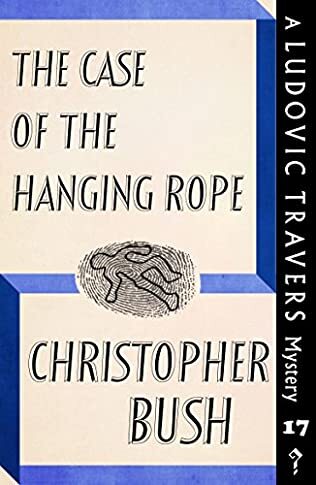The Case Of The Hanging Rope

A review of The Case of the Hanging Rope by Christopher Bush
I normally enjoy Christopher Bush’s Ludovic Travers series, but I found this seventeenth adventure, originally published in 1937 and reissued by Dean Street Press, a tad disappointing. Also known as The Wedding Night Murder, the society beauty and pioneering airwoman, Sonia Vorge, whose wedding Travers has witnessed, is found murdered on her bridal bed in Montage Hall and her hubby is drugged in the other room with a rope fashioned like a noose above his bed. Shortly after the murder, the butler espies the ghost of Montage Hall stalking the corridor.
Inevitably, there is more to all this than a simple murder of a scheming and unpleasant woman, who has a murky past. We quickly enter a world of sophisticated international art theft using the latest in new-fangled technology, a private aeroplane, and competitive contract bridge as a front. Travers and Wharton of the Yard have their work cut out to work out what is going on, a task not helped by some enormous red herrings and some intriguingly solid alibis.
Bush has invested most of his energy in constructing some ingenious methods to construct an alibi, one distinctly Heath-Robinsonish involving a kettle and the other, slightly preposterously, using a dog of a breed notorious for their ability to snore. Travers works them out and once he has clarity that some of the suspects were not where they were at the time they said they were, he moves closer to solving the mystery.
I think part of my problem with this book is the role of Travers himself. His method of eliciting information from suspects are a little unconventional to say the least, bordering on entrapment. He also decides to play judge and jury, playing fast and loose with the law, making personal deals with one of the culprits to the extent that they evade the arms of the law once they have restored some property. He also places another into a position where the only way out is for them to take their own life, something, to his credit, Travers regrets, although perhaps he should have seen where it was all going to end up.
Despite their amiable relationship, their repartee is one of the highlights of the book, Travers and Wharton keep their distance from each other, feeding each other such information they have garnered as they feel necessary but each playing their own distinctive game.
The ending of the book is a little too rushed, given the time that has spent in setting up the mystery, and there are too many questions and loose ends to make it a truly satisfying case. The rope, for example, is sufficiently important enough to take its place in the book’s title, but in the end it is just another piece in the jigsaw rather than the central plotting device around which the story hangs. It is, though, worth spending some time studying the family tree Bush has provided at the beginning of the book to cement the relationships in your mind. They can be confusing especially as the first names of two of the protagonists with the same family name both begin with P.
On the positive side, Bush writes with some vigour, not a little humour and keeps the plot moving. There are also some intriguing contemporary references, including one to Mr Growser, the disgruntled grocer in the children’s radio show, Toytown, and the Coronation, not the one that sparked off the Jubilee celebrations that were on-going when I finished the book, but that of George VI on May 12, 1937.
This is a book for the completist rather than one to discover Bush with.



